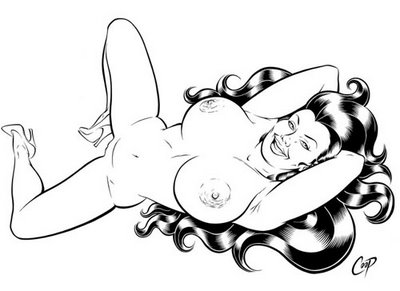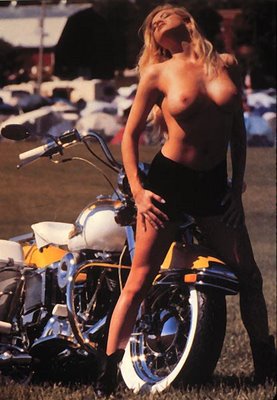
Nude (study for Atari), 2005
Ink on paper
24 x 19 in. / 26 x 21 in. framed

Rubber Catsuit (study for Goodyear), 2006
Ink on paper
24 x 19 in. / 26 x 21 in. framed

Distortion Pedal, 2006
Ink on paper
19 x 24 in. / 21 x 26 in. framed
In his third solo exhibition at sixspace in Culver City, CA, USA,
Coop presents new
acrylic-on-canvas paintings and ink-on-paper works in Brand
Recognition. Continuing his exploration of re-appropriation,
Coop expands on dissecting his own iconic imagery, popular
culture, and art historical references with his new series
of bold, sexy, and smart paintings. Concurrent with main exhibition,
the gallery's project room space will feature the debut
showing of his preparatory sketches.
Brand Recognition deals with the prevalence of corporate
logos in contemporary society and how they have integrated
seamlessly into our culture. Being both fascinated and repelled
by the ubiquity of these logos, Coop addresses how they have
moved passed being simple eye-catching advertisements and
how they have become a part of how we self-identify in society.
Combining these easily recognizable corporate images with
his own popular brand, Coop touches upon the duality of himself
becoming complicit in the very subject that he often finds
so troubling.
Coop came out to Los Angeles from Bixby, Oklahoma in the
late 1980s and quickly became regarded as one of the preeminent
underground artists of his time - his iconic imagery of devil
girls, smoking devil, and cars has solidified his place in
pop-culture history. Exhibitions of his work have been held
in galleries and museums in Los Angeles, London, New York,
Chicago, and Zurich, Switzerland. His most recent solo exhibition,
Parts with Appeal at sixspace in 2004, contained
an ambitious continuous 78-foot multi-panel painting depicting
fragmented and re-constructed images of the iconic figures
he has created. Publications featuring Coop's work have
included Artweek, Juxtapoz, Paper Magazine, Playboy, The
Los Angeles Alternative Press, and Rodders Journal.
2001 saw the publication of his first book -
"Devil's
Advocate: the Art of Coop" - and his popular sketchbook
"The Big Fat One" was released in 2004.
See all posts on Coop.

































